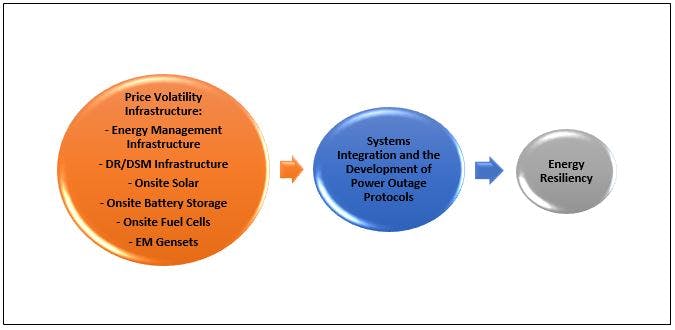Over the past decade, the frequency and intensity of catastrophic weather events exposing vulnerabilities on the electrical distribution system have increased. Businesses have experienced billions in revenue losses annually. The frequency and intensity of these disruptions are forecasted to increase, putting many operations at risk. In addition, increasing environmental compliance regulations and technological advancement are making zero-emissions, distributed energy technologies price competitive. The investment in Energy Resiliency strategies will provide a competitive advantage for business operations.
What is Energy Resiliency?
In summary, Energy Resiliency is an organization’s ability to maintain operations through major power supply interruptions. Energy Resiliency serves as a key component of managing business and revenue risks and can lead to significant disruptions and unanticipated costs if not implemented correctly.
The core deliverable of an Energy Resiliency Plan is to provide contingency measures for power supply interruptions or outages affecting an operation. In order to deliver this Resiliency Plan, there is the integration of individual systems into a scheme (Energy Resiliency Strategy) that delivers the contingency measures to mitigate the effect of power interruptions on the operation. If designed and integrated correctly, these individual systems can deliver additional value streams to the business operation, therefore increasing the overall value of Energy Resiliency to the business.
Energy Resiliency Strategy Design
Understanding a business’s exposure and its overall environmental strategy are key to the design of a suitable Energy Resiliency Strategy. A well-designed strategy provides two main operational value streams to businesses:
- Pricing Controls – The plans and systems in place to mitigate energy price volatility risks.
- Contingency Measures for Power Outages – The protocols and systems in place to maintain operations through major power supply interruptions.
Fig. 1. Energy Resiliency process flow
Investment Considerations for Energy Resiliency
Too frequently, only when major energy related interruptions occur are costly operational vulnerabilities exposed. The development and deployment of an Energy Resiliency Strategy provides a competitive advantage for a business and the absence of one will create gaping vulnerabilities with costly implications for revenue and brand integrity.
Energy Resiliency requires organizational commitment and capital investment (CAPEX). Resiliency investments can provide strong rates of return (ROIs) and business value to competitively vie for CAPEX allocation. There are incentive and development dollars available in specific markets to support the development of Energy Resiliency schemes. Factoring operational savings, risk mitigations and incentive dollars further increases the financial value of Energy Resiliency investments. Important investment considerations include:
- The risk profile and exposure of the Organization
- The CAPEX requirements or financial framework for solution implementation
- The benefits to the Organization (financial and operational)
- The technological capabilities of solution (response time, ride through duration, etc.)
- The environmental impact of solution
- The ease of implementation of solution (permitting, impact on facility operations, etc.)
- The facilities to be targeted across Organization
- The ability to scale solutions
Value Proposition of Energy Resiliency
The key framework of a robust Energy Resiliency Strategy is one which provides tangible operational benefits to the business such as cost control or energy savings and serves as contingency measure to mitigate power supply interruption impacts of business operation.
A comprehensive assessment of an Organization’s position on environmental, social and governance (ESG) commitments are key drivers in demonstrating the overall value proposition of an Energy Resiliency Strategy. The delivery of all these can be achieved though the implementation of a comprehensive plan.
How Do Energy Resiliency Needs Change Going Forward?
- The magnitude and frequency of catastrophic weather and climate events are projected to increase. Having a strategy to mitigate the adverse impact on operations will provide a competitive advantage for businesses.
Fig. 2. NOAA billion-dollar weather and climate disasters that impacted the United States during 2020. < https://www.ncdc.noaa.gov/billions/>
- Regulatory guidance is increasingly directing utility operations to be proactive with widespread safety shut offs as a precautionary measure to preserve life and property. This trend presents massive business interruption risks and is gradually expanding.
- Environmental regulations and technology developments are driving lower investment costs on Distributed Energy Resource (DER) technologies or penalizing businesses for not investing in zero-emissions DER technologies.
- Environmental and social stewardship are increasingly becoming key investment indicators for businesses.
How APTIM Can Support Energy Resiliency Development Efforts
APTIM’s approach to Energy Resiliency is centered around developing and delivering integrated solutions aligned with an Enterprise-wide Energy Strategy. We have strong environmental, regulatory, permitting, engineering, and construction management capabilities. We can leverage our national utility network to identify development and financing opportunities to support.
APTIM can support customers with the development and execution of:
- Vulnerability/risk assessments
- Energy assurance planning
- Resiliency strategy development
- Utility/incentive programs
- Pilot solutions
- Short-term resiliency solutions
- Turn-key integrated resiliency solutions
- Construction & project management


